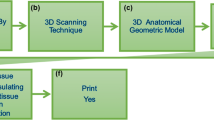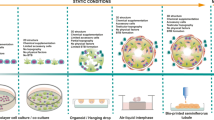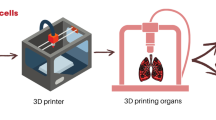Abstract
Introduction
Human mesenchymal stem cells (hMSCs) holds great promise for managing several clinical conditions. However, the low engraftment efficiency and obscurity to harvest these cells without compromising the cellular viability, structural and functional properties from the culture niche still remain major obstacles for preparing intact regenerative constructs. Although few studies have demonstrate different methods for generating cell-liberated amniotic scaffolds, a common method for producing completely cell-liberated amnion (D-HAM) and chorion (D-HCM) scaffolds and their cytocompatibility with hMSCs yet to be demonstrated.
Methods
A common process was developed for preparing D-HAM and D-HCM scaffolds for assessing hMSCs engraftment efficiency, proliferation and molecular shifts to generate cell-laden biological discs. The structural and functional integrity of D-HAM and D-HCM was evaluated using different parameters. The compatibility and proliferation efficiency of hMSCs with D-HAM and D-HCM was evaluated.
Results
Histological analysis revealed completely nucleic acid-free D-HAM and D-HCM scaffolds with intact extracellular matrix, mechanical and biological properties almost similar to the native membranes. Human MSCs were able to adhere and engraft on D-HCM better than D-HAM and expanded faster. Ultrastructural observations, crystal violet staining and expression studies showed better structural and functional integrity of hMSCs on D-HCM than D-HAM and control conditions.
Conclusion
A common, simple and reliable process of decellularization can generate large number of cell-liberated amniotic scaffolds in lesser time. D-HCM has better efficiency for hMSCs engraftment and proliferation and can be utilized for preparing suitable cell-laden constructs for tissue engineering applications.






Similar content being viewed by others
References
Barton, K., D. L. Budenz, P. T. Khaw, and S. C. G. Tseng. Glaucoma filtration surgery using amniotic membrane transplantation. Investig. Ophthalmol. Vis. Sci. 42(8):1762–1768, 2001.
Bozzola, J. J., and L. D. Russell. Electron Microscopy Principles and Techniques for Biologists, 2nd ed. Sudbury, MA: Jones and Bartlett Publishers, 1998.
Bryksin, A. V., A. C. Brown, M. M. Baksh, M. G. Finn, and T. H. Barker. Learning from nature—novel synthetic biology approaches for biomaterial design. Acta Biomater. 10(4):1761–1769, 2014. https://doi.org/10.1016/j.actbio.2014.01.019.
Chomczynski, P., and N. Sacchi. Single-step method of RNA isolation by acid guanidinium thiocyanate-phenol-chloroform extraction. Anal. Biochem. 162:156–159, 1987. https://doi.org/10.1006/abio.1987.9999.
Crapo, P. M., T. W. Gilbert, and S. F. Badylak. An overview of tissue and whole organ decellularization processes. Biomaterials. 32(12):3233–3243, 2011. https://doi.org/10.1016/j.biomaterials.2011.01.057.
Dan, P., É. Velot, G. Francius, P. Menu, and V. Decot. Human-derived extracellular matrix from Wharton’s jelly: an untapped substrate to build up a standardized and homogeneous coating for vascular engineering. Acta Biomater. 48:227–237, 2017. https://doi.org/10.1016/j.actbio.2016.10.018.
Dehghani, S., M. Rasoulianboroujeni, H. Ghasemi, S. H. Keshel, Z. Nozarian, M. N. Hashemian, M. Zarei-Ghanavati, G. Latifi, R. Ghaffari, Z. Cui, H. Ye, and L. Tayebi. 3D-Printed membrane as an alternative to amniotic membrane for ocular surface/conjunctival defect reconstruction: an in vitro & in vivo study. Biomaterials. 174:95–112, 2018. https://doi.org/10.1016/j.biomaterials.
Figueiredo, G. S., S. Bojic, P. Rooney, S. P. Wilshaw, C. J. Connon, R. M. Gouveia, C. Paterson, G. Lepert, H. S. Mudhar, F. C. Figueiredo, and M. Lako. Gamma-irradiated human amniotic membrane decellularised with sodium dodecyl sulfate is a more efficient substrate for the ex vivo expansion of limbal stem cells. Acta Biomater. 61:124–133, 2017. https://doi.org/10.1016/j.actbio.2017.07.041.
Francisco, J., C. Ricardo, A. C. Marco, R. B. Simeoni, B. F. Mogharbel, L. P. Gledson, S. M. D. Dilcele, C.G.-S. Luiz, and C. Katherine. Decellularized amniotic membrane scaffold as a pericardial substitute: an in vivo study. Transplant Proc. 48(8):2845–2849, 2016. https://doi.org/10.1016/j.transproceed.2016.07.026.
Frazão, L. P., J. Vieira de Castro, C. Nogueira-Silva, and N. M. Neves. Decellularized human chorion membrane as a novel biomaterial for tissue regeneration. Biomolecules. 10(9):1208, 2020. https://doi.org/10.3390/biom10091208.
Gholipourmalekabadi, M., M. Sameni, D. Radenkovic, M. Mozafari, M. Mossahebi-Mohammadi, and A. Seifalian. Decellularized human amniotic membrane: how viable is it as a delivery system for human adipose tissue-derived stromal cells? Cell Prolif. 49(1):115–121, 2016. https://doi.org/10.1111/cpr.12240.
Gilbert, T. W., T. L. Sellaro, and S. F. Badylak. Decellularization of tissues and organs. Biomaterials. 27(19):3675–3683, 2006. https://doi.org/10.1016/j.biomaterials.2006.02.014.
Go, Y. Y., S. E. Kim, G. J. Cho, S.-W. Chae, and J.-J. Song. Differential effects of amnion and chorion membrane extracts on osteoblast-like cells due to the different growth factor composition of the extracts. PLoS ONE.12:e0182716, 2017. https://doi.org/10.1371/journal.pone.0182716.
Grey, C., Tissue engineering scaffold fabrication and processing techniques to improve cellular infiltration. Dissertation, Virginia Commonwealth University, Richmond, 2014.
Gupta, A., S. D. Kedige, and K. Jain. Amnion and chorion membranes: potential stem cell reservoir with wide applications in periodontics. Int. J. Biomater. 2015:1–9, 2015. https://doi.org/10.1155/2015/274082.
Hamid, S., A. Muhammad, S. Zikria, I. Mehwish, I. Muhammad, D. Zeeshan, and K. Asif Manzoor. Mesenchymal stem cells (MSCs) as skeletal therapeutics—an update. J. Biomed. Sci. 23(41):1–15, 2016. https://doi.org/10.1186/s12929-016-0254-3.
Jie, J., J. Yang, H. He, L. Zhang, Z. Li, J. Chen, M. Vimalin Jeyalatha, Z. Liu, and W. Li. Tissue remodeling after ocular surface reconstruction with denuded amniotic membrane. Sci. Rep. 8(1):6400, 2018. https://doi.org/10.1038/s41598-018-24694-4.
Kakabadze, Z., K. Mardaleishvili, G. Loladze, I. Javakhishvili, K. Chakhunasvili, L. Karalashvili, N. Sukhitashvili, G. Chutkerashvili, A. Kakabadze, and D. Chakhunasvili. Clinical application of decellularized and lyophilized human amnion/chorion membrane grafts for closing post-laryngectomy pharyngocutaneous fistulas. J. Surg. Oncol. 113(5):538–543, 2016. https://doi.org/10.1002/jso.24163.
Kannaiyan, J., S. Suriya-Narayanan, M. Palaniyandi, B. Rajangam, C. Hemlata, and P. Anubhav. Amniotic membrane as a scaffold in wound healing and diabetic foot ulcer: an experimental technique and recommendations. IJRMS. 2016. https://doi.org/10.18203/2320-6012.ijrms20162206.
Khalil, S., N. El-Badri, M. El-Mokhtaar, S. Al-Mofty, M. Farghaly, R. Ayman, H. Dina, and M. Noha. A cost-effective method to assemble biomimetic 3D cell culture platforms. PLoS ONE.11(12):e0167116, 2016. https://doi.org/10.1371/journal.pone.0167116.
Koob, T. J., J. J. Lim, M. Massee, N. Zabek, R. Rennert, G. Gurtner, and W. W. Li. Angiogenic properties of dehydrated human amnion/chorion allografts: therapeutic potential for soft tissue repair and regeneration. Vasc Cell. 1(6):10, 2014. https://doi.org/10.1186/2045-824X-6-10.
Kshersagar, J., R. Kshirsagar, S. Desai, R. Bohara, and M. Joshi. Decellularized amnion scaffold with activated PRP: a new paradigm dressing material for burn wound healing. Cell Tissue Bank. 19(3):423–436, 2018. https://doi.org/10.1007/s10561-018-9688-z.
Lee, J. W., W. Y. Park, E. A. Kim, and I. H. Yun. Tissue response to implanted Ahmed glaucoma valve with adjunctive amniotic membrane in rabbit eyes. Ophthalmic Res. 51(3):129–139, 2014. https://doi.org/10.1159/000357097.
Li, X., L. Duan, Y. Liang, W. Zhu, J. Xiong, and D. Wang. Human umbilical cord blood-derived mesenchymal stem cells contribute to chondrogenesis in coculture with chondrocytes. Biomed. Res. Int. 2016:3827057, 2016. https://doi.org/10.1155/2016/3827057.
Lim, R. Concise review: fetal membranes in regenerative medicine: new tricks from an old dog? Stem Cells Transl. Med. 6(9):1767–1776, 2017. https://doi.org/10.1002/sctm.16-0447.
Litwiniuk, M., M. Radowicka, A. Krejner, A. Śladowska, and T. Grzela. Amount and distribution of selected biologically active factors in amniotic membrane depends on the part of amnion and mode of childbirth. Can we predict properties of amnion dressing? A proof-of-concept study. Cent. Eur. J. Immunol. 43(1):97–102, 2018. https://doi.org/10.5114/ceji.2017.69632.
Maiti, S. K., M. U. Shiva Kumar, L. Srivastava, A. R. Ninu, and K. Naveen. Isolation, proliferation and morphological characteristics of bone-marrow derived mesenchymal stem cells (BM-MSC) from different animal species. Trends Biomater. Artif. Organs. 27(1):29–35, 2013.
Massee, M., K. Chinn, J. Lei, J. J. Lim, C. S. Young, and T. J. Koob. Dehydrated human amnion/chorion membrane regulates stem cell activity in vitro. J. Biomed. Mater. Res. B Appl. Biomater. 104(7):1495–1503, 2016. https://doi.org/10.1002/jbm.b.33478.
Massee, M., K. Chinn, J. J. Lim, L. Godwin, C. S. Young, and T. J. Koob. Type I and II diabetic adipose-derived stem cells respond in vitro to dehydrated human amnion/chorion membrane allograft treatment by increasing proliferation, migration, and altering cytokine secretion. Adv. Wound Care (New Rochelle). 5(2):43–54, 2016. https://doi.org/10.1089/wound.2015.0661.
McQuilling, J. P., J. B. Vines, K. A. Kimmerling, and K. C. Mowry. Proteomic comparison of amnion and chorion and evaluation of the effects of processing on placental membranes. Wounds. 29(6):E36–E40, 2017.
Meller, D., V. Dabul, and S. C. Tseng. Expansion of conjunctivital epithelium cells on amniotic membrane. Exp. Eye Res. 74:537–545, 2002. https://doi.org/10.1006/exer.2001.1163.
Mohammadi, A. A., S. M. Seyed Jafari, M. Kiasat, A. R. Tavakkolian, M. T. Imani, M. Ayaz, and H. R. Tolide-ie. Effect of fresh human amniotic membrane dressing on graft take in patients with chronic burn wounds compared with conventional methods. Burns. 39(2):349–353, 2013. https://doi.org/10.1016/j.burns.2012.07.010.
Monteiro, B. G., R. R. Loureiro, P. C. Cristovam, J. L. Covre, J. Á. P. Gomes, and I. Kerkis. Amniotic membrane as a biological scaffold for dental pulp stem cell transplantation in ocular surface reconstruction. Arq. Bras. Oftalmol. 82(1):32–37, 2019. https://doi.org/10.5935/0004-2749.20190009.
Naasani, L. S., A. F. Damo Souza, C. Rodrigues, S. Vedovatto, J. G. Azevedo, A. P. S. Bertoni, M. Da Cruz Fernandes, S. Buchner, and M. R. Wink. Decellularized human amniotic membrane associated with adipose derived mesenchymal stromal cells as a bioscaffold: physical, histological and molecular analysis. Biochem. Eng. 152:107366, 2019. https://doi.org/10.1016/j.bej.2019.107366
Ngadiman, N. H. A., M. Y. Noordin, A. Idris, and D. Kurniawan. A review of evolution of electrospun tissue engineering scaffold: from two dimensions to three dimensions. Proc. Inst. Mech. Eng. Part H J Eng. Med. 231(7):597–616, 2017. https://doi.org/10.1177/0954411917699021.
Paolin, A., E. Cogliati, D. Trojan, C. Griffoni, A. Grassetto, H. M. Elbadawy, and D. Ponzin. Amniotic membranes in ophthalmology: long term data on transplantation outcomes. Cell Tissue Bank. 17(1):51–58, 2016. https://doi.org/10.1007/s10561-015-9520-y.
Parry, S., and J. F. Strauss III. Premature rupture of the fetal membranes. N. Engl. J. Med. 338(10):663–670, 1998. https://doi.org/10.1056/NEJM199803053381006.
Porzionato, A., E. Stocco, S. Barbon, F. Grandi, V. Macchi, and R. De Caro. Molecular sciences tissue-engineered grafts from human decellularized extracellular matrices: a systematic review and future perspectives. IJMS. 19(12):4117, 2018. https://doi.org/10.3390/ijms19124117.
Rana, D., S. Arulkumar, A. Vishwakarma, and M. Ramalingam. Considerations on Designing Scaffold for Tissue Engineering. Stem Cell Biology and Tissue Engineering in Dental Sciences. New York: Academic Press, pp. 133–148, 2015.
Rao Pattabhi, S., J. S. Martinez, and T. C. Keller 3rd. Decellularized ECM effects on human mesenchymal stem cell stemness and differentiation. Differentiation. 88(4–5):131–143, 2014. https://doi.org/10.1016/j.diff.2014.12.005.
Rieder, E., M.-T. Kasimir, G. Silberhumer, G. Seebacher, E. Wolner, P. Simon, and G. Weigel. Decellularization protocols of porcine heart valves differ importantly in efficiency of cell removal and susceptibility of the matrix to recellularization with human vascular cells. J. Thorac. Cardiov. Surg. 127(2):399–405, 2004. https://doi.org/10.1016/j.jtcvs.2003.06.017.
Saghizadeh, M., M. A. Winkler, A. A. Kramerov, D. M. Hemmati, C. A. Ghiam, S. D. Dimitrijevich, D. Sareen, L. Ornelas, H. Ghiasi, W. J. Brunken, E. Maguen, Y. S. Rabinowitz, C. N. Svendsen, K. Jirsova, and A. V. Ljubimov. A simple alkaline method for decellularizing human amniotic membrane for cell culture. PLoS ONE.8(11):e79632, 2013. https://doi.org/10.1371/journal.pone.0079632.
Salah, R. A., I. K. Mohamed, and N. El-Badri. Development of decellularized amniotic membrane as a bioscaffold for bone marrow-derived mesenchymal stem cells: ultrastructural study. J. Mol. Histol. 49(3):289–301, 2018. https://doi.org/10.1007/s10735-018-9768-1.
Sara, L. M., K. Thomas, H. Nicola, P. Olena, F. Carsten, B. Martin, F. Constanca, G. Birgit, and G. Oleksandr. Human amniotic membrane: a review on tissue engineering, application, and storage. J. Biomed. Mater. Res. B Appl. Biomater. 2021:1–18, 2020. https://doi.org/10.1002/jbm.b.34782.
Schenke-Layland, K. From tissue engineering to regenerative medicine—the potential and the pitfalls. Adv. Drug Deliv. Rev. 63(4–5):193–194, 2011. https://doi.org/10.1016/j.addr.2011.04.003.
Strauss, J. F., 3rd. Extracellular matrix dynamics and fetal membrane rupture. Reprod. Sci. 20(2):140–153, 2013. https://doi.org/10.1177/1933719111424454.
Taghiabadi, E., S. Nasri, S. Shafieyan, S. J. Firoozinezhad, and N. Aghdami. Fabrication and characterization of spongy denuded amniotic membrane based scaffold for tissue engineering. Cell J. 16(4):476–487, 2015. https://doi.org/10.22074/cellj.2015.493.
Tiziana, S., P. Gianfranco, and G. Umberto. Clinical trials with mesenchymal stem cells: an update. Cell Transplant. 25(5):829–848, 2016. https://doi.org/10.3727/096368915x689622.
Wang, M., Y. Yang, D. Yang, F. Luo, W. Liang, S. Guo, and J. Xu. The immunomodulatory activity of human umbilical cord blood-derived mesenchymal stem cells in vitro. Immunology. 126(2):220–232, 2009. https://doi.org/10.1111/j.1365-2567.2008.02891.x.
Wilshaw, S. P., J. N. Kearney, J. Fisher, and E. Ingham. Production of an acellular amniotic membrane matrix for use in tissue engineering. Tissue Eng. 12:2117–2129, 2006. https://doi.org/10.1089/ten.2006.12.2117.
Wilshaw, S. P., J. Kearney, J. Fisher, and E. Ingham. Biocompatibility and potential of acellular human amniotic membrane to support the attachment and proliferation of allogeneic cells. Tissue Eng. Part A. 14:463–472, 2008. https://doi.org/10.1089/tea.2007.0145.
Yang, S., K.-F. Leong, Z. Du, and C.-K. Chua. The design of scaffolds for use in tissue engineering. Part I. Traditional factors. . Tissue Eng. 7(6):679–689, 2001. https://doi.org/10.1089/107632701753337645.
Zare-Bidaki, M., S. Sadrinia, S. Erfani, E. Afkar, and N. Ghanbarzade. Antimicrobial properties of amniotic and chorionic membranes: a comparative study of two human fetal sacs. J. Reprod. Infertil. 18(2):218–224, 2017.
Acknowledgments
This study was supported by the grant received from Indian Council of Medical Research (ICMR) in form of Research Associate Fellowship (RA, No. 5/3/8/3/ITR-F/2019-ITR) to Sandeep Kumar Vishwakarma. All authors thank to Owaisi Hospital and Research Centre for material supply.
Conflict of interest
Chandrakala Lakkireddy, Nagarapu Raju, Shaik Iqbal Ahmed, Avinash Bardia, Mazharuddin Ali Khan, Sandhya Annamaneni, and Aleem Ahmed Khan declare that they have no conflict of interest.
Consent to Participate
All the participants in the study provided signed inform consent forms prior to the sample collection
Consent to Publish
All the participants in the study agreed for publishing this study
Ethical Approval
Institutional Review Board has approved present study
Author information
Authors and Affiliations
Corresponding author
Additional information
Associate Editor Michael R. King oversaw the review of this article.
Publisher's Note
Springer Nature remains neutral with regard to jurisdictional claims in published maps and institutional affiliations.
Rights and permissions
About this article
Cite this article
Lakkireddy, C., Vishwakarma, S.K., Raju, N. et al. Fabrication of Decellularized Amnion and Chorion Scaffolds to Develop Bioengineered Cell-Laden Constructs. Cel. Mol. Bioeng. 15, 137–150 (2022). https://doi.org/10.1007/s12195-021-00707-7
Received:
Accepted:
Published:
Issue Date:
DOI: https://doi.org/10.1007/s12195-021-00707-7




